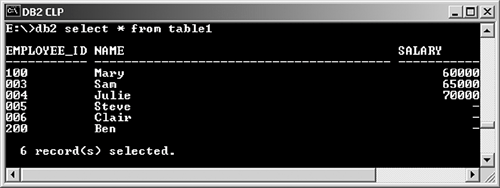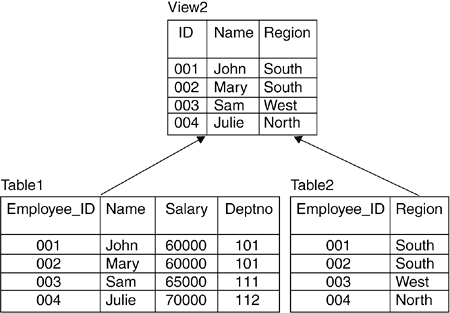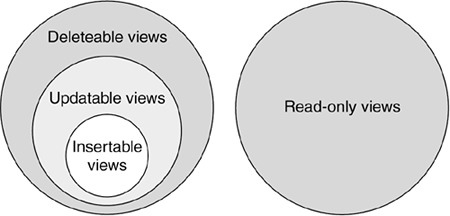Section 7.11. Views
7.11. ViewsA view is a virtual table derived from one or more tables or other views. It is virtual because it does not contain any data, but a definition of a table based on the result of a SELECT statement. Figure 7.21 illustrates view view1 derived from table table1. Figure 7.21. A view derived from a table
A view does not need to contain all the columns of the base table. Its columns do not need to have the same names as the base table, either. This is illustrated in Figure 7.21, where the view consists of only two columns, and the first column of the view has a different name than the corresponding column in the base table. This is particularly useful for hiding confidential information from users. You can create a view using the CREATE VIEW statement. For example, to create the view view1 shown in Figure 7.21, issue this statement. CREATE VIEW view1 (id, name) AS SELECT employee_id, name FROM table1 To display the contents of view1, use the following statement. SELECT * FROM view1 You can also create views based on multiple tables. Figure 7.22 shows a view created from two tables. Figure 7.22. A view derived from two tables
Here is the corresponding CREATE VIEW statement for Figure 7.22. CREATE VIEW view2 (id, name, region) AS SELECT table1.employee_id, table1.name, table2.region FROM table1,table2 WHERE table1.employee_id = table2.employee_id With this statement we have combined the information of table1 and table2 into view2, while limiting access to the salary information. When you create a view, its definition is stored in the system catalog table SYSCAT.VIEWS. This table contains information about each view such as its name, schema, whether or not it is read-only, and the SQL statement used to create the view. For example, in Figure 7.23 we show part of the information for views view1 and view2 in SYSCAT.VIEWS. Figure 7.23. View definitions stored in the SYSCAT.VIEWS table When a view is referenced in a query, DB2 reads and executes the view definition from the SYSCAT.VIEWS table, pulls the data from the base table, and presents it to the users. To remove a view, use the DROP VIEW statement. For example, to remove the view view1 use: DROP VIEW view1 If any of the base tables or views is dropped, the views that are dependent on them will be marked invalid and the value in the VALID column shown in Figure 7.23 will be set to X instead of Y. When this happens, you will not be able to use these views. This is true even if you have recreated the base table or view afterward. 7.11.1. View ClassificationViews are classified by the operations they allow. There are four classes of views:
In the SYSCAT.VIEWS catalog table, when the value of the column READ-ONLY is Y, this indicates that the view is read-only; otherwise, it is either a deleteable, updatable, or insertable view. Figure 7.23 shows view2 is a read-only view, but view1 is not. Figure 7.24 illustrates the relationship between the different types of views. The views are discussed further in the next sections. Figure 7.24. View classifications and relationships
7.11.1.1 Deleteable ViewsA deleteable view allows you to execute the DELETE statement against it. All of the following must be true.
For further detail, refer to the DB2 UDB SQL Reference manual. In our previous example, view1 is a deleteable view. However, view2 is not because it does not follow the first rule. In view2's definition, the SELECT statement contains two base tables in the FROM clause. 7.11.1.2 Updatable ViewsAn updatable view is a special case of a deleteable view. A view is updatable when at least one of its columns is updatable. All of the following must be true.
In our previous example, view1 is an updatable view. However, view2 is not because it is not deleteable. You can update view1 using the UPDATE statement, and the changes will be applied to its base table. For example, the following statement changes the value of column employee_id to 100 for records with the name value of Mary in table1. UPDATE view1 SET id='100' WHERE name = 'Mary'; 7.11.1.3 Insertable ViewsAn insertable view allows you to execute the INSERT statement against it. A view is insertable when all of its columns are updatable. For example, view1 fits this rule. The following statement will insert a row into table1, which is the base table of view1. INSERT INTO view1 VALUES ('200', 'Ben'); Figure 7.25 displays the contents of table1 after executing the INSERT statement on view1. Note that the salary and deptno columns for Ben contain NULL values because these two columns are not contained in view1. Figure 7.25. Contents of table1 after inserting a row into view1 If table1 were defined such that NULL values were not allowed in one of the salary or deptno columns, the INSERT statement would fail, and view1 would not be an insertable view. 7.11.1.4 Read-Only ViewsA read-only view is not deleteable. In Figure 7.22, shown earlier, view2 is a read-only view. Its read-only property is also stored in the SYSCAT.VIEWS table, which is shown in Figure 7.23. NOTE Even if a view is read-only, INSERT, UPDATE, and DELETE operations are still possible by using an INSTEAD OF trigger. For more information, see section 7.13, Triggers. 7.11.2. Using the WITH CHECK OPTIONYou can define a view to selectively display a subset of rows of its base table by using the WHERE clause in the CREATE VIEW statement. To ensure that all the INSERT and UPDATE operations conform to the criteria specified in the WHERE clause of the view, you can use the WITH CHECK OPTION clause. For example, let's create the view view3 derived from table table1 (see Figure 7.22) as follows. CREATE VIEW view3 (id, name,deptno) AS SELECT employee_id, name, deptno FROM table1 WHERE deptno = 101 WITH CHECK OPTION If you issue a SELECT * FROM view3 statement, you will obtain the following result: ID NAME DEPTNO --- -------------------- ----------- 001 John 101 002 Mary 101 Only two rows are retrieved because these are the only rows that satisfy the WHERE clause. What happens if you issue the following statement? INSERT INTO view3 VALUES ('007','Shawn',201) This statement fails because 201 does not conform to the criteria of the WHERE clause used in the CREATE VIEW definition, which is enforced because of WITH CHECK OPTION. If view3 had not been defined with this clause, the INSERT statement would have succeeded. 7.11.3. Nested ViewsNested views are ones based on other views, for example: CREATE VIEW view4 AS SELECT * FROM view3 In this example, view4 has been created based on view3, which was used in earlier examples. The WITH CHECK OPTION clause specified in view3 is still in effect for view4; therefore, the following INSERT statement fails for the same reason it fails when inserting into view3. INSERT INTO view4 VALUES ('007','Shawn',201) When a view is defined with the WITH CHECK OPTION clause, the search condition is propagated through all the views that depend on it. |
EAN: 2147483647
Pages: 313


